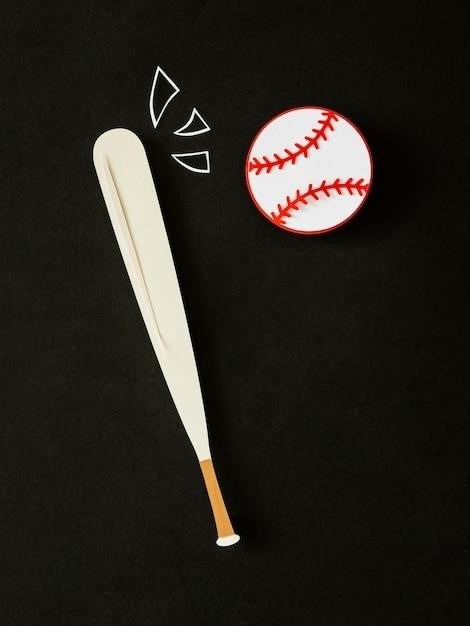Softball Signs and Signals⁚ A Comprehensive Guide
This comprehensive guide explores the intricate world of softball signs and signals, covering defensive, offensive, and umpire signals, as well as common signal usage, signal theft, and the importance of clear communication. We will also delve into resources for learning softball signals, the use of technology, and safety and etiquette considerations. This guide will provide a comprehensive understanding of the crucial role of signs and signals in softball, equipping coaches, players, and fans with the knowledge necessary for a successful and enjoyable game.
Defensive Signs
Defensive signs are essential for coordinating the defensive strategy on the field. The most common defensive signs are those used by the catcher to communicate the type of pitch to the pitcher. These signs are typically a series of hand signals or gestures that are pre-determined by the coach. The catcher’s job is to quickly and discreetly convey the pitch selection to the pitcher, ensuring the pitcher can execute the desired pitch without the batter knowing the plan. This communication is crucial for keeping the batter off balance and preventing them from hitting the ball effectively.
In addition to pitch type, defensive signs can also communicate the placement of the fielders, the type of defensive strategy to use, and other important information. The catcher is often the primary signal giver, but coaches can also use signs to communicate with players on the field. Coaches may use a combination of hand signals, numbers, or even verbal cues to direct the defense.
The effectiveness of defensive signs relies heavily on clear communication and the ability of the players to understand and execute the signals quickly and accurately. Coaches must ensure their players are well-trained in the chosen signal system and that they can effectively communicate with each other during the game.
Offensive Signs

Offensive signs play a crucial role in softball by enabling the batter and baserunners to anticipate the pitcher’s actions and execute strategic plays. The coach or manager typically communicates these signs to the players on the field, often using a combination of hand signals, numbers, or even verbal cues. The signs might indicate the desired type of hit, the location to aim for, or whether a base runner should attempt to steal a base.
For instance, the coach might signal to the batter to “take” the pitch, meaning they should not swing and observe the pitch’s trajectory. This information helps the batter adjust their approach and anticipate the next pitch. Similarly, the coach might signal to a runner on first base to “steal second,” prompting them to take off towards the next base while the pitcher is focused on the batter.
The effectiveness of offensive signs depends on their clarity, consistency, and the players’ ability to quickly decipher and execute them. Teams often develop unique sign systems to prevent opponents from deciphering their strategies. The use of offensive signs allows the team to maintain a strategic advantage and maximize their chances of scoring runs.
Umpire Signals
Umpire signals are an essential aspect of softball games, conveying crucial decisions and rulings to both players and spectators. These signals are standardized across various levels of play, ensuring consistent interpretations of game rules and fairness. The signals are typically executed with hand gestures, accompanied by verbal pronouncements.
For example, a common signal involves the umpire raising their right arm to indicate a strike. A ball is signaled by extending the left arm and then the right arm to indicate the number of strikes. Other signals include a safe call, an out call, a foul ball, and a dead ball.
These signals not only provide clarity to the players about the umpire’s rulings but also ensure transparency and accountability within the game. The use of standardized signals helps maintain order, prevent disputes, and foster a fair and enjoyable playing environment for all participants.
Common Softball Signals
Beyond the standard umpire signals, a variety of common softball signals are used by coaches and players to communicate strategic intentions during the game. These signals, often executed with subtle hand gestures or specific movements, can be crucial for success in various situations.
One common signal is the “take sign”, which instructs the batter not to swing at the pitch, allowing them to take a pitch and potentially set up a better hitting opportunity later. Another signal is the “wipe off sign”, used by the coach to dismiss all previous signals and start fresh with new instructions.
In addition to these basic signals, teams might use specific signals for various plays, such as a steal attempt, a bunt, or a hit-and-run. These signals are often tailored to a team’s unique offensive strategies and can provide a competitive edge if executed effectively.
Signal Theft
Signal theft is a common practice in competitive softball, where teams attempt to decipher their opponents’ signs and signals to gain an advantage. This can involve various tactics, from observing the catcher’s movements to using binoculars or even employing hidden cameras.
Sophisticated signal theft often involves carefully analyzing the catcher’s hand signals and patterns, looking for subtle variations or inconsistencies that might reveal the intended pitch or play. Some teams may use specific techniques to disguise their signals, making them harder to decode, while others employ counter-measures to prevent signal theft.
Signal theft can be a significant factor in determining the outcome of a game, especially at the highest levels of competition. While ethical considerations are important, the need to outsmart opponents and gain an advantage often drives teams to explore various methods of deciphering their opponents’ plans.
Importance of Clear Communication
Clear communication is paramount in softball, as it ensures that players understand the coach’s instructions and respond effectively to the evolving game situation. The use of signs and signals provides a crucial communication channel, allowing coaches and players to convey information quickly and efficiently.
Effective communication through signs and signals can lead to smoother gameplay, reduced errors, and increased team performance. A well-rehearsed system of signs and signals minimizes confusion and allows players to anticipate plays, react swiftly, and execute their roles with confidence.
Clear communication also fosters a cohesive team environment, promoting trust and understanding among players. By establishing a shared language of signs and signals, players can work together seamlessly, maximizing their individual strengths and contributing to the team’s overall success.
Resources for Learning Softball Signals
Learning softball signals can be an enriching experience for players, coaches, and fans alike. Several resources are available to help you acquire this valuable knowledge. Online platforms offer a wealth of information on softball signals, including comprehensive guides, tutorials, and videos. These resources often provide explanations of different types of signals, their meanings, and practical tips for implementing them effectively;
Softball coaching manuals and books offer in-depth coverage of signs and signals, providing detailed explanations of specific strategies and techniques; These resources can be particularly helpful for coaches who want to develop a comprehensive sign system for their team.
Attending softball clinics and workshops can provide valuable hands-on learning experiences. These events often feature expert coaches who share their knowledge and expertise on signs and signals, offering practical tips and insights into the art of communication on the field;
Using Technology to Learn Softball Signals
Technology has revolutionized the way we learn and interact with sports, and softball is no exception. Numerous technological tools and resources are available to help players, coaches, and fans learn and understand softball signals. Online learning platforms offer interactive courses, video tutorials, and quizzes that make learning engaging and accessible. These platforms often feature expert coaches who provide detailed explanations and practical demonstrations of different types of signals.
Mobile apps designed specifically for softball provide a convenient way to learn and practice signals on the go. These apps typically include signal dictionaries, practice drills, and even games that allow users to test their knowledge in a fun and interactive way.
Video analysis software allows coaches to record and review games, identifying patterns in their team’s signal usage and potential areas for improvement. This technology can be particularly helpful for teams that want to refine their signaling system and enhance communication on the field.
Safety and Etiquette
While signs and signals are essential for effective communication in softball, it’s crucial to prioritize safety and maintain proper etiquette. Clear and concise communication is key to preventing misunderstandings and ensuring everyone’s safety on the field. Coaches should emphasize the importance of players staying focused and alert during the game, avoiding distractions that could lead to misinterpretations of signals.
Players should maintain respectful communication with coaches, umpires, and opposing players, avoiding any actions that could be perceived as disrespectful or disruptive. This includes refraining from making unnecessary noise or gestures during the game, and always acknowledging the umpire’s decisions with respect, even if they disagree.
When learning new signals, players should take the time to understand the meaning of each signal and practice them diligently. This ensures that players can respond accurately and effectively to signals during the game, minimizing confusion and potential safety hazards.
